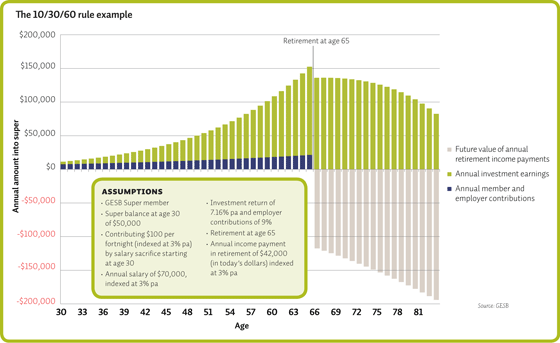Get clients saving more with the 10/30/60 Rule





by Tony Vidler ![]()
![]()
![]()
 One of the biggest issues for advisers is to get clients saving more. Getting them to do now what will be good for later means deferring instant gratification and the constant “we wants”, even in countries where compulsory or incentivised retirement savings schemes exist.
One of the biggest issues for advisers is to get clients saving more. Getting them to do now what will be good for later means deferring instant gratification and the constant “we wants”, even in countries where compulsory or incentivised retirement savings schemes exist.
A fascinating piece of work for any advisers working with retirement planning was done a number of years ago by Don Ezra, which became dubbed the 10/30/60 Rule, which is well worth pointing out to clients as it SHOULD sell the concept that saving more makes a world of difference to the life choices they will have.
In brief it established as a reasonably reliable principle that
It is worth mentioning that when this piece of work was done in 1989 the focus was placed upon analysing the relative contributions to retirement spending from Defined Benefit retirement plans. Of course, such schemes have largely fallen by the wayside around the world over the last decade, replaced by Defined Contribution (DC) structures.
Interestingly, in the DC environment the analysis suggests that there is a stronger leaning towards the 10/30/60 Rule being applicable. Remembering that it is only a “rule of thumb” with a number of variables which can distort the actual outcome, it is still useful as an information, or point of sale concept, for clients as what it does do is highlight the importance of having accumulated a fund which will provide some 60% of their future requirements AFTER retiring.
It would be fair to say that most clients should have be aware by now of the effect of compound interest on their savings growth, because we have made a point of educating consumers about the impact of compound interest on long term savings. I think it would be equally fair to say though that relatively few clients understand the power and impact of the retirement plan, or investment portfolio, continuing to generate further growth post-retirement.

While the 10/30/60 Rule does not hold true enough to be a solid planning principle that can be relied upon for needs analysis forecasting perhaps, it is an extremely useful concept that is academically robust enough to use as an educational principle with clients that should encourage the growth of retirement savings plans without scaremongering tactics.
Isn’t that what we want to achieve?
Comments (1)